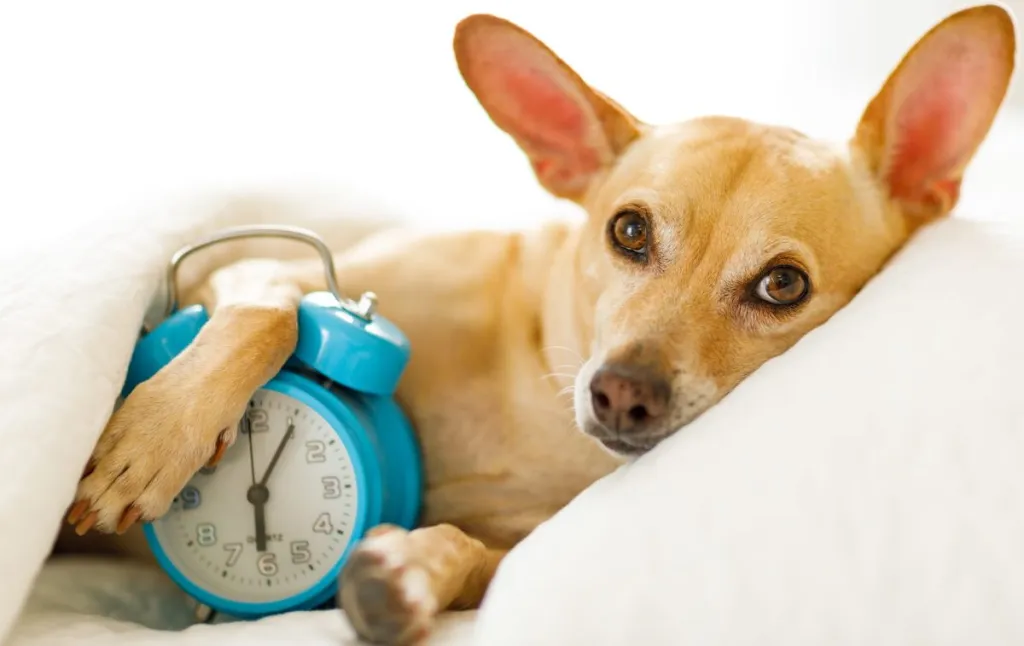Daylight Saving Time begins on Sunday, March 10, 2024, at 2:00 a.m. Probably a sensation familiar to everyone, the early jumpstart on the day can leave you feeling a bit discombobulated. If you think you feel funky from the change, your pup may also feel odd from the leap in time. Here are a few ways your dog might struggle during this time and what you can do to help them adjust.
Are dogs affected by Daylight Saving Time?
The short answer is yes. Like humans, dogs can be very sensitive to unexpected adjustments in routine. Unlike humans, who adhere to clock-based schedules, animals rely on their internal circadian rhythms. This biological clock regulates their daily activities, such as eating, sleeping, and bathroom breaks. When humans change the clock for the start of Daylight Saving Time, it can affect dogs more strongly. The abrupt change in time can disrupt their usual schedule for feeding, bathroom breaks, and exercise — leading to confusion and potential stress. Some dogs will be less affected by the change than others, but it’s generally a good rule to help your dog acclimate to the best of your ability.
Potty time
At the end of Daylight Saving Time, many dogs may find it challenging to adjust their morning bathroom routine thanks to their humans indulging in the extra hour of sleep. Your pup might express their urgency by whining at the door, begging you to wake up and let them out. While this situation might not occur at the beginning of Daylight Saving Time, your dog may still feel perplexed by the early wake-up call. Because most dogs adhere to consistent potty times throughout the day, they may need time to adapt to the new schedule. Make sure your pup gets enough time to do their business without you trying to rush them if you’re running late from oversleeping.
Feeding time
If your dog is used to eating at a certain time, they might be a bit confused when breakfast arrives early. It’s unlikely they’ll be too upset about it, but they may wonder, “Why am I eating right now?” When breakfast is served earlier than expected, they may find themselves questioning the change in routine. However, dogs are generally adaptable and are unlikely to be deeply disturbed by the alteration in mealtime. That said, they may be asking for dinner a bit earlier or try begging for some treats to make it through the night until they adjust.
Together time with your dog during the start of Daylight Saving Time
When you leave home, your dog misses you. You’re their family, part of their pack. They’ll probably be a bit disappointed when you bounce out of bed an hour earlier. Make sure you plan for the jumpstart to the day to keep the remainder of your pup’s morning routine consistent. Throwing things off too much could lead to all sorts of unwanted behavior from stress. This may be particularly true for sensitive dog breeds. As such, this shift could result in your pup having accidents or chewing.
How do I change my dog’s internal clock?
In the weeks leading up to the start of Daylight Saving Time, adjust your schedule by a few minutes at a time. Set your alarm a few minutes earlier than usual, giving you and your dog enough time to slowly adapt. Gradually shift your dog’s feeding, bathroom, and walk times by 10–15 minutes during the week leading up to the time change. This can help your pup’s internal clock to acclimate. Most of all, pay extra attention to your dog’s needs during this transition. It is important to offer them extra comfort if they show signs of anxiety.
As Daylight Saving Time begins, make sure you ease the effects of your new schedule on your dog. Enjoy the longer hours of sunlight and warmer weather. This way, you can make the Daylight Saving Time switch a positive experience rather than a stressful one.









